As with One from late in the fourth season, Infinite Regress is an episode that uses Seven of Nine’s cybernetic mind as a vehicle for psychological horror.
Producer Brannon Braga has always been interested in constructing psychological thrillers within the science-fiction framework of Star Trek, using the franchise’s pseudo-science trappings as a way to explore themes of mental deterioration or disconnect. Frame of Mind is probably the first example, but there are many others. Braga is very interested in having his characters question the nature of their reality, of trapping them within their own minds, of undercutting their sense of self. That interest bled into the shows around him.

Self-image.
Star Trek: Voyager presented the writers with an artificial computer-generated character who could more readily combine the writer’s fascination with psychological thrillers and the franchise’s engagement with advanced technology. The EMH was a character whose mind was comprised entirely of computer protocols and software code. His mind could be unfurled on monitors, buffered in memory, fragmented on the hard drive. Episodes like Projections, The Swarm and Darkling suggested a character prone to psychosis, reinforced by Dejaren’s breakdown in Revulsion.
However, the addition of Seven of Nine to the cast in Scorpion, Part II seemed to provide the the Voyager writers (and Braga in particular) with character who could function as an even more effective vehicle for these sorts of stories. Seven is a fusion of human and machine, an organic brain augmented by technological components. She is a character whose mind is in many ways already divided, whose sense of self is understandably fragile. As such, Seven is ideally suited to stories like Infinite Regress.

Mind your step.
Infinite Regress finds Seven of Nine experiencing something of a mental breakdown. As Voyager finds itself approaching the remains of a destroyed Borg Cube, Seven begins undergoing severe personality changes. It is gradually revealed that she is manifesting several distinct personalities; “the Son of K’vok”, “Daimon Torrot”, “Subaltern Lorot”, the mother of Gregory Bergan. The crew determine that Seven is giving voice to the personalities of people who have been assimilated by the Borg Collective, that the collective unconscious is speaking through her.
Infinite Regress explicitly couches this plot element in psychological terms. After Tuvok is forced to subdue Seven, Janeway advises her, “We believe you’re experiencing a neurological disorder.” The EMH’s initial diagnosis is more medical than technological. “In essence, you’ve developed the Borg equivalent of Multiple Personality Disorder,” he advises her. Although the cause of this breakdown is eventually explained as technological in nature, the framework is very organic and psychological.

Getting into her head.
As Duncan Barrett and Michèle Barrett note in The Human Frontier, Voyager has a recurring fascination with putting its artificial (or cybernetic) characters through extreme mental stress:
In Voyager, the character of Seven of Nine alone has suffered from a catalogue of severe psychological problems, including false recovered memory syndrome (Retrospect), multiple personality disorder (Infinite Regress), hallucinations (One) and paranoid schizophrenia (The Voyager Conspiracy). In fact, Voyager has even presented us with a severe mental pathology derived from more time travel than is good for you – Captain Breaxton has developed the dreaded ‘temporal psychosis’! Even the holograms on Voyager have psychological problems: the Doctor runs through his Byronic paces in Darkling, in Revulsion he meets another ‘isomorph’ who has an obsession with cleanliness, and in Flesh and Blood he encounters a bloodthirsty hologram with a messiah complex.
To be fair, the fifth season of Voyager has also featured two entirely organic characters who have grappled with severe psychological issues; Janeway in Night and Torres in Extreme Risk. However, the “artificial” characters on Voyager feel particularly prone to psychological affliction.
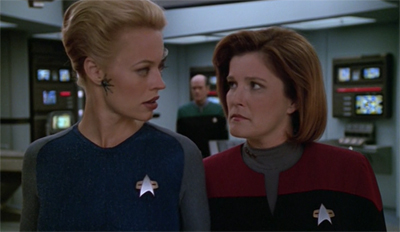
“The Doctor says you might have the dreaded ‘space psychosis’.”
Mental health has long been a fascination of popular culture, but often in a very superficial way. Many classic horror films are rooted in exaggerated (and violent) portrayals of mental illness. The Shining is the story of a struggling writer who has a nervous breakdown and decides to murder his family. Raising Cain is the tale of a man driven to extremes by multiple personality disorder. Psycho famously closes with an extended expository monologue from a psychiatrist. Halloween takes place on the night that Michael Myers escapes from Smith’s Grove Sanitorium.
Of course, these portrayals are deeply problematic. At best, they offer incredibly simplified understandings of psychological conditions like schizophrenia. At worst, they create a dangerous stigma around mental illness. Indeed, it is worth noting that people who suffer from mental illness are statistically less violent towards others than the general population, a detail that is understandable at odds with the portrayal of mental illness in horror films.
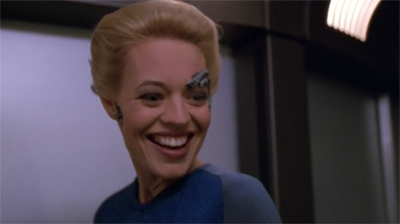
Smiles to go.
However, mental health became a more mainstream concern at the end of the eighties and into the nineties. After all, Star Trek: The Next Generation went to the effort of putting a mental health professional on the bridge and seating right next to the captain. The statistics suggested that populations in the developed world were suffering from higher rates of mental illness as the twentieth century drew to a close.
In Britain, the number of people being treated for mental illnesses by the National Health Services increased by five hundred percent between 1948 and 1998. In the United States, diagnoses of depression and anxiety soared between 1930 and 1990. That number has increased in the shorter term, with more people reporting symptoms of depression in the 2010s as compared to the 1980s. Public awareness has increased even further in the intervening years, with the number of Americans acknowledging knowing somebody with mental illness doubling between 1991 and 2002.
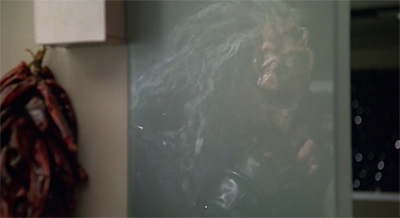
Seven isn’t feeling herself lately.
More than eight million people in the United States live with a mental health issue. Between eight and ten percent of Americans take antidepressents. Depression is the leading cause of disability worldwide, according to the World Health Organisation. This issue bubbled into the public consciousness during the nineties. Daniel J. Kevles lamented the state of affairs in January 1997:
Today, in the United States, some five and a half million people over the age of nine are estimated to suffer from severe mental illness, almost half of them enduring without treatment. The proportion, once large, of such people kept in state psychiatric hospitals has fallen drastically, the result of a 40-year movement known as ”deinstitutionalization.” Nowadays, many mentally ill Americans are in nursing homes that provide custodial attention but little else. Roughly 159,000 of the untreated acutely ill are in prison, mostly for minor crimes like shoplifting; another 150,000 of them are homeless, and they make up about one-third of those outcasts of our affluence.
People were increasingly aware of mental illness within modern society, and the impact that it had on individuals. There was a palpable anxiety about these conditions, and about the toll that they exacted upon those who suffered with them.
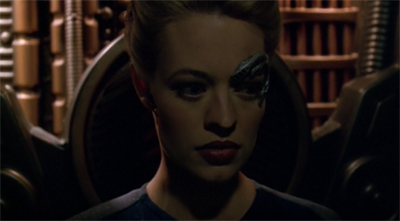
Night terrors.
Naturally, this increased awareness and diagnosis of mental illness has sparked its own debates and its own fascinations. Journalists and writers will frequently wonder what it is about modernity that seems to threaten the fragile psychological stability of the human mind. Taken at face value, these statistics can provide a jumping off point into a discussion of any aspect of the modern world. After all, there is something powerful in the ironic idea that mankind has built a modern world in which they are not equipped to survive.
Of course, the science underpinning these arguments is highly debatable, for any number of reasons. Most obviously, the scientific understanding of the human brain is always evolving, and so the understanding of mental illness is similarly flexible over long periods of time; it is very hard to compare “like” with “like” in this scenario. Similarly, the historical record of these diagnoses (and even the reporting of symptoms) is highly suspect for the purpose of drawing trends. People are more willing these days to acknowledge mental illness, both as patients and as doctors.

Game for this debate.
While this idea might have a very questionable basis in scientific fact, it still seemed to seep into the popular consciousness. As the final years of the twentieth century drew to a close, popular culture seemed increasing anxious about the human mind’s capacity to process the world around it. Everything was moving so fast, with so much uncertain. The nineties were an era of economic prosperity and relative political stability, but they were also an era of rapid social and technological change.
Pop culture suggested an increasingly fractured sense of reality, as reflected in the boom of virtual reality film and television leading up to the turn of the millennium; The Matrix, The Truman Show, The Thirteenth Floor, Dark City, Harsh Realm. There was a sense that reality – and the mind’s grip on reality – was an increasingly fragile thing. There was often a feeling of sensory overload and hyper-reality to the last years of the twentieth century; the nineties was the era of twenty-four-hour news, The Jerry Springer Show, pro-wrestling, the internet.
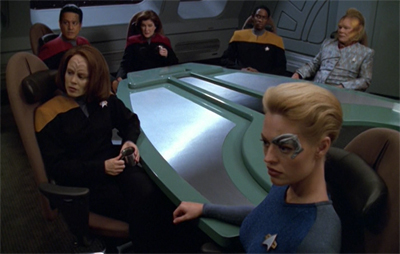
Have you ever questioned the nature of your reality?
There was information overload, with no quality assurance. There was no way to know what was truly real and what was simply illusory. Conspiracy theories took root, and spread like wildfire through popular culture and internet message boards. Everything was negotiable, up for grabs. The real and the unreal co-mingle. These themes were undoubtedly of interest to Brannon Braga on Voyager. The show had a recurring fixation with the unreal and the illusory; temporal duplicates, clones without memory, holographic duplicates, con artists, figures of legend.
Voyager was a show that routinely blew up the ship and killed off the cast in episodes like Deadlock, Year of Hell, Part II, Timeless and Course: Oblivion, but which always ensured that everything was always put back together in a logical manner for the next episode. Holographic duplicates of the crew would populate episodes like Worst Case Scenario, Living Witness and Author, Author. Braga would play into themes of paranoia in scripts like Future’s End, Part II, Latent Image and The Voyager Conspiracy.
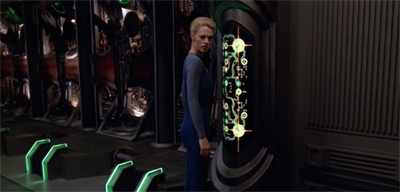
Logging her unease.
No wonder Braga tended to gravitate toward identity crises in characters like the EMH or Seven of Nine. These were characters who were arguably even less “real” than their fellow crewmembers, and yet who are perhaps more real for that. The EMH and Seven have repeated breakdowns over the course of Voyager, in which they find themselves questioning what is real and what is not; the EMH in Projections and Latent Image, Seven in One and The Voyager Conspiracy. There is no small irony in this, that the two artificial crew members should be asked to arbitrate what is real.
Although Infinite Regress is framed as a multiple personalities story, it plays more like a story of possession. After all, the personalities inhabiting Seven of Nine are not fragments of her self, shattered by some traumatic experience. Instead, Seven is giving voice to those who have been assimilated by the Borg Collective. Infinite Regress is effectively a ghost story, a tale of the dead speaking through a conduit. In keeping the franchise’s use of artificial characters in this way, it recalls the use of Data to house the D’Arsay spirits in Masks from the final season of The Next Generation.

Bringing matters to a head.
In fact, the original pitch for the episode was even more explicit in its necromancy. As Kenneth Biller explained to Cinefantastique, the original idea for Infinite Regress was a lot more focused:
The original idea of the episode was that Seven met one person who was trying to pull out of Seven the personality of some loved one who had been assimilated by the Borg. That seemed a little far-fetched, that you could dig out one specific personality out of somebody who was a Borg that had assimilated millions of people. My contribution to that episode, other than guiding Rob Doberty through the writing of the script, was to say that this would be a lot more interesting if something weird happens to Seven. It does begin to set off a multiple personality disorder, and she begins to manifest all these different personalities that turn out to be the people that she assimilated. I thought that was great, a tour de force for Jeri Ryan.
Of course, this act of necromancy-through-technology would also hark back to earlier stories within the franchise, whether the resurrection of Juliana Tainer as an android in Inheritance or Kila Marr’s use of Data as a conduit to her dead son in Silicon Avatar.

A distorted sense of self.
The climax of Infinite Regress literalises this horror movie atmosphere as Tuvok uses his mind meld to venture into Seven of Nine’s subconscious. The scene is shot through a warped fish-eye lens, designed to disorient the audience. The surroundings themselves are built from elements of various Borg sets over the history of the franchise. Once Tuvok enters Seven’s subconscious, he finds himself attacked by an angry mob. There is no sense of individuality, just screams and grunts and agony.
Seven’s subconscious is presented as a hellish nightmare, a monstrous environment that threatens to consume both Seven and Tuvok. Seven is no longer in control of her faculties, she is just one voice among “hundreds of other personalities.” As with the exploration of Seven of Nine’s psyche in One, this is a fascinating twist on the very idea of the Borg Collective. In Infinite Regress, Seven is not worried about being subsumed by the Collective, she is worried about being subsumed by the voices in her own head.

“My mind to your mind, our minds are more than one hundred…”
In Mind, Modernity and Madness, Liah Greenfield argues that mental illness is related to broader cultural concerns, and could be seen as an inevitable response to a world in which people enjoy greater freedom than ever to choose their own identity and forge their own destiny:
The reason for the dysfunction of the acting self lies in the malformation of identity. It is possible that the complexity of the original identity problem (the depth and number of inconsistencies in the relationally constituted self) contributes to the complexity of the disease; for instance, in a case of dissatisfaction with one’s nevertheless clearly experienced identity causing depression, and in a case of no clearly experienced identity, combined with numerous competing possibilities, producing schizophrenia. It is modern culture—specifically the presumed equality of all the members of the society, secularism, and choice in self-definition, implied in the national consciousness—that makes the formation of the individual identity difficult. A member of a nation can no longer learn who or what s/he is from the environment. Instead of prescribing to us our identities, as do religious and in principle nonegalitarian cultures, modern culture leaves us free to decide what to be and to make ourselves. It is this cultural laxity that is anomie—the inability of a culture to provide the individuals within it with consistent guidance (already in the beginning of the twentieth century, recognized by Durkheim as the most dangerous problem of modernity). Paradoxically, in effect placed in control over our destiny, we are far more likely to be dissatisfied with it, than would be a person deprived of any such control: not having a choice, such a person would try to do the best with what one has and enjoy it as far as possible. A truly believing person would also feel s/he has no right to find fault with the order of things created by God, much less to try and change it to one’s own liking—one’s situation in life would be perceived as both unchangeable and just. Conversely, the presence of choice, the very ability to imagine oneself in a position different from one currently occupied or that of one’s parents, and the idea that social orders in general are created by people and may be changed make one suspect that one’s current situation is not the best one can have and to strive for a better one. The more choices one has, the less secure one becomes in the choices already made (by one or for one) and making up one’s mind—literally, in the sense of constructing one’s identity—grows increasingly difficult. It is for this reason that the malformation of the mind—quite independent of any disease of the brain—becomes a mark of nations.
Obviously, this is a rather broad philosophical response to a very real mental health issue. Its medical application is highly debatable. However, it does provide a thematic connection between the existential anxieties of the late twentieth century and the same period’s fascination with mental illness.
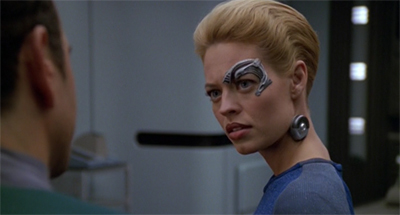
Implanting the seeds of self-doubt.
Voyager is a show that is very consciously rooted in the nineties, and very informed by the events (and the outlook) of that decade. Its fascination with time travel and its conscious lack of forward momentum could be seen to reflect the decade’s worries about standing at the the end of history. Its recurring engagement with the theme of revisionist history could be seen as playing with the nineties’ anxiety over postmodernism and the growing worries about the lack of a single agreed history.
The nineties were a decade in which the United States lacked a clear external enemy against which it might define itself. The Soviet Union had collapsed at the start of the decade, ending the Cold War. Japan’s economy largely collapsed into a lost decade, removing a major economic rival. The United States economy was robust, employment was high, crime was down, the Doomsday Clock was further from midnight than ever before. People had more choice and more freedom than they had ever enjoyed before, and fewer restrictions or worries.
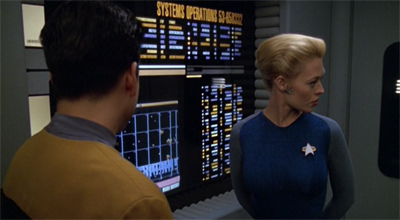
A choice problem.
The paradox of all this is that more freedom and more choice threatened to become paralysing. Infinite possibilities lead to infinite anxieties, as an infinite array of options only increased the sense that people were more likely to be making the wrong choice. This is arguably true at every level of human experience, from “big” decisions like careers and college course down to smaller choices like shopping for clothes. It is an existential crisis, one that is delightfully ironic. More freedom seems to create more problems.
Voyager seems to use Seven of Nine to explore this crisis. Repeatedly over the course of Voyager, the character struggles with the freedom and individuality that was denied to her as a Borg drone. Free from the Borg Collective, Seven of Nine is free to be anybody that she wants to be. Infinite Regress takes that idea to its logical extreme, suggesting that Seven is free to be literally anyone. She does not have to be Annika Hansen, she can be “the Son of K’vok”, “Daimon Torrot”, “Subaltern Lorot”, or any one of hundred different people.
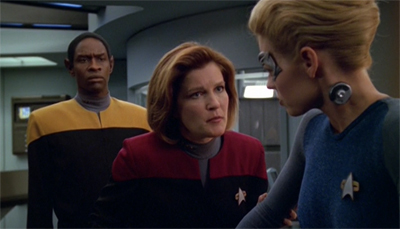
To thine own selves be true.
Infinite Regress even makes a repeated point to contextualise this particular crisis as part of Seven’s larger journey towards becoming human. “Seven, you were a Borg drone who’s now becoming an individual,” the EMH explains. “That’s practically unheard of. There’s bound to be rough spots along the way.” He’s not alone in that sentiment. “I’m starting to wonder if my First Officer was right all along,” Janeway confesses to Chakotay after one particularly exhausting session with Seven. “You always said that bringing Seven into the fold might be impossible.”
Although Infinite Regress eventually reveals a pseudo-technological justification for Seven’s condition, there is a strong sense that it is just a heightened expression of a long-simmering identity crisis. Following her liberation from the Borg Collective in The Gift, Seven has the freedom to choose who she wants to be, which has been a source of tension in episodes like Prey and Hope and Fear. It makes sense to see that idea pushed to its logical extreme, heightened and amplified through this plot element.

Hanging out.
The plot element in question is the vinculum. As Joe Menosky explained to Cinefantastique, the idea actually originated in a different pitch, but Brannon Braga quickly became attached to it:
Jimmy Diggs pitched a totally unrelated episode that had to do with finding a destroyed Borg ship. Himmy came up with the vinculum, the central processing unit for the collective mind. Brannon wanted the vinculum, and it was going to be a maddening tech story, Brannon insisted. That vinculum ended up an albatross around his neck. Brannon paid the price for it, because he had to do a massive amount of rewriting. It was a very difficult script to get in shape.
Indeed, the vinculum is a rather strange idea. It seems like a concept that really should support its own episode, but which is mercilessly shunted into the background of a completely different episode.
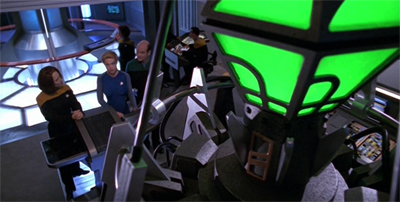
It’s certainly an interesting angle on the story.
After all, the very premise of the vinculum is fascinating, particularly as a point of intersection between the technological and the organic elements of the Borg Collective. Janeway is understandably anxious about beaming the device into engineering. “We’re talking about the heart of a Borg Cube,” she reflects. “I’d rather not take it inside my ship.” It is interesting to imagine the vinculum as a heart transplant, as the cold mechanical heart of a Borg ship. How would it interact with Voyager? What effect would it have? Would it poison the ship?
Later in the episode, it is revealed that the vinculum has been tainted and infected, contaminated by a “Typhoid Mary” that weaponised the process of assimilation. This is itself an interesting idea for a story, perhaps so interesting that Voyager would revisit it with the Brunali in Child’s Play. Still, the idea of a dysfunctional Borg Cube, of the Collective suffering a breakdown in their network like a twenty-fourth century slant on colony collapse disorder, is striking. It feels a shame to keep it so out of focus.

“Attempted genocide? Please, tell me more.”
This sense of a rushed plot plays out in the debate between Janeway and Ven over the vinculum. Ven is effectively advocating an attempted mass murder of the Borg, enacting a plan very similar to the one that Picard considered in I, Borg. It is a plot to weaponise assimilation against the Borg to the point of using their heavily networked existence against them. It is a horrifying idea, but Infinite Regress simply brushes past the plot point because there is so much else happening in the plot.
“We designed that virus to destroy Borg, Captain,” Ven insists. “We never considered a treatment. I’m afraid your drone won’t survive. But we must return the vinculum to the debris field immediately. If the Borg arrive first, we’ll have lost our chance, and those thirteen people will have died in vain.” Janeway never questions the morality of the plan, nor the question of her complicity. She agrees in principle. “All right. We’ll return it to you, but first we need to try to save our crew member. We think we have a way to counteract the Vinculum’s effects.”
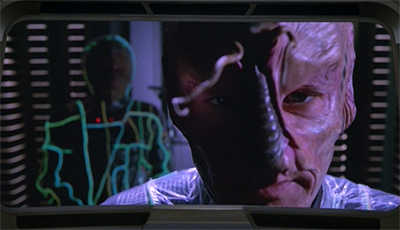
Typhoid 6339.
To be fair, director David Livingston does the best that he can with the material provided to him. The vinculum is really just a prop dangling from the ceiling of a standing set, immobile and passive. However, Livingston makes a conscious effort to shoot it from odd angles, even evoking the way that Kubrick approached the obelisk in 2001: A Space Odyssey. Ultimately, the vinculum doesn’t do much within the episode, feeling largely redundant and cluttering the narrative, but the camera still treats it with a sense of awe and wonder.
That said, it is hard to complain too much about the decision to sideline the vinculum. Like many episodes of television built around multiple personalities, Infinite Regress is clearly designed as a showcase for performer Jeri Ryan. Ryan is one of the most talented performers in the cast, and it’s difficult to imagine even Mulgrew or Picardo rising to a challenge like this. However, Ryan throws herself into the role, and plays about half a dozen different (and clearly distinct) personalities over the course of the hour.
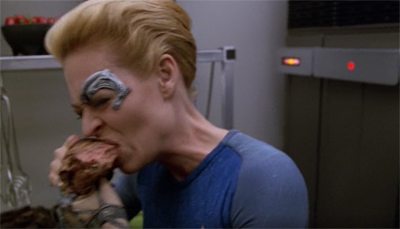
A role for Ryan to sink her teeth into.
Ryan’s human characters are notable of themselves, from a concerned mother looking for her son to a little girl who wants to play games. However, particularly impressive are Ryan’s impressions of iconic Star Trek aliens like Klingons, Vulcans and Ferengi. As Ryan confessed to Cinefantastique, it was tough:
I had no research time. I had never really seen a Ferengi at that point. They were throwing tapes at me from episodes of DS9 that had Ferengis in them, so that I could at least watch how they move and how they talk. They were throwing Klingon tapes at me, because really the only Klingon I had encountered was B’Elanna [Roxann Dawson], and that doesn’t count because she is only half-Klingon.
Ryan’s physicality is amazing, to the point that it’s quite clear to see what species she is playing based simply on how she moves. The teaser does not need the shot of her Klingon reflection, and the scene in astrometrics is a dead-on impersonation of Aron Eisenberg. And she does it without prosthetics.
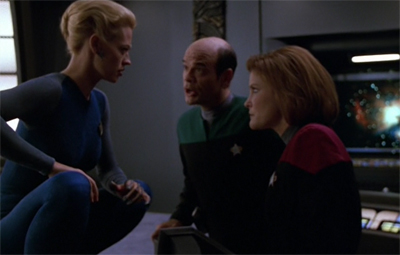
Dealing with it.
Infinite Regress is also notable for introducing the idea of a relationship between Seven of Nine and Naomi Wildman, something teased in Once Upon a Time. The relationship is interesting on a number of levels, particularly in how it allows Ryan to shade Seven a bit more and for the humour of identifying Naomi as “subunit of Ensign Samantha Wildman.” However, the relationship works for an even more fundamental reason. It would be fair to argue that Seven and Naomi are the only children on board.
To be fair, Voyager has struggled with how best to approach the issue of Seven’s mental and emotional age. Most obviously, episodes like The Gift and Revulsion leaned heavily into the idea of Seven as a sexualised character; the catsuit in many ways suggests that she is to be treated as a sex object, while a lot of the creative choices around the character seem intended to present her as a blonde almost-dominatrix “ice queen” in a way that mirrors the treatment of the Borg Queen in stories like Star Trek: First Contact.

Child’s play.
However, the show also repeatedly emphasised that Seven of Nine was basically a little girl who had lost twenty years of her life to the Borg Collective. Underneath the catsuit, Seven was arguably still trying to find Annika Hansen, as reinforced by episodes like The Raven, Dark Frontier, Part I and Dark Frontier, Part II. More than that, episodes like The Gift, Prey and Hope and Fear presented Seven as something like a rebellious teenage daughter to Janeway, suggesting somebody who was still developing.
This that in mind, it makes sense to bring Seven and Naomi together, to allow Seven to interact with somebody who has a roughly similar amount of life experience, and to acknowledge that Seven is not necessarily a fully-formed adult in the same way that the rest of the cast might be. (Early episodes focusing on the EMH, like Lifesigns touched on this idea, but Seven has largely supplanted the EMH from that point of view.) There is something genuinely heartwarming in the dynamic as suggested by Infinite Regress.

That healthy green glow.
Infinite Regress is an episode that is a little clumsy in scripting and construction, overstuffed with superfluous plot elements like the vinculum. However, it is also a fascinating showcase for Jeri Ryan as a performer and a fascinating addition to Voyager‘s study of cybernetic psychological breakdown.
Filed under: Voyager | Tagged: borg, drones, hyperreality, jeri ryan, Mental Health, millennium, modernity, multiple personality disorder, personality, reality, seven of nine, star trek: voyager |




















It’s weird but while I liked Seven a lot when I was watching ‘Voyager’ back in the day, I think finding out more about the toxic atmosphere onset and the (very justifiable) anger of much of the rest of the cast at being pushed further down the ladder has changed my view of Seven. I guess part of it is that having read Mulgrew and the rest of the original cast and Ryan’s comments I find myself more sympathetic to Mulgrew even though I prefer Ryan’s performance and (I must admit) onscreen performer. That plus going through these reviews at fairly high speed means my reaction on seeing this pop up was to groan ‘yet ANOTHER Seven episode?’
I don’t even remember the episode in question, though it sounds fascinating and I have no trouble believing Jeri Ryan’s skill but I’m having… I don’t know, retroactive burn out at the overuse of the character and actor if that makes any kind of sense
“I don’t even remember the episode in question”
I streamed it about it year ago, and it really is excellent. Reminds me a little of MacAvoy’s performance in “Split”.
R: Mulgrew
I’ve joined in a few debates about Voyager (offline and on) and it’s interesting that few people take Mulgrew’s side. At the end of the day, she was “just another” TV star who stepped on everyone’s lines and acted like a diva. It’s not a good look.
If Jeri were a bad performer, then it would be a much different situation; (un?)fortunately, it was thanks to her that Voyager wasn’t cancelled and everyone kept her jobs. To Kate’s chagrin no doubt.
Doesn’t help that Janeway was often mis-characterized and dull. Seven had a fairly developed character throughout.
I think Mulgrew had a reputation for causing trouble behind the scenes as well. There was the infamous press junket/television press association event where she seemed to threaten to quit and then had to roll back her comments by personally phoning every journalist in attendance.
Yeah, it’s particularly obvious when you watch in bulk, when the episodes aren’t spaced apart by weeks or months. Which is a shame, because the character is interesting and Ryan is great.
What’s so interesting about this episode is how Voyager manages to pull off the whole ‘kid wants to be a Starfleet officer’-gimmick that TNG completely bungled in its first seasons. A large part of that is due to the better writing and acting, but I also think it just fits the show better dramatically. For Voyager, having a kid around means something; it highlights that the ship and its crew need to adapt for the long voyage home, and be open to nostandard situations (like, you know, having an ex-Borg on the ship), which is otherwise a bit neglected on the show.On TNG, having kids on the ship had no real point or logic to it, it was just there. And that’s before we get to episodes like Rascals.
I’m sure DS9 did much better on the topic of parenthood, but I find the fact that Voyager handled kids a lot better than TNG did very interesting.
I don’t care for Naomi, but the “Borg Kids” were a good surprise. Maybe it’s because the Borg are such “great material” that’s very hard to get it wrong with them.
And the kid playing Icheb was no actor of no small talent. Hard to remember now that Hawaii Five O has survived an inexplicable ten seasons, but back in the nineties, TV attracted a certain pedigree of actor. They didn’t let just anyone in front of a camera.
But I remember rolling my eyes at the introduction of a bunch of Borg rugrats on the ship, and vowing never to watch the show again, a promise I kept for a decade for a long while.
Yeah, that’s part of the reason I don’t mind Naomi Wildman as much as some seem to. She’s certainly a better fit for me than the Borg children, to pick one example.
Drinking game, take a shot every time you mention the end of history hypothesis! Even the biggest wine-o in the world would pass out by the end 😛
Fair point, Mark, fair point!
But I only mention it because it doesn’t seem to be part of the critical discourse around Voyager, and I think it’s an essential part of that discourse.
Jeri Ryan is a fantastic actress and she her best with what she is written, but the writing of the different aliens is just dreadful. Voyager never really wrote Klingons well, just look at the Klingon in Unimatrix Zero, but the personality in this episode is equally awful. It just blindly bites Toress and generally acts like an idiot. This is especially infuriating after all the good work that DS9 has done with the Klingons in characters like Marton and Gowron. Similarly, the Ferengi is a total cartoon. Just think of how tragic this episode could have been if these aliens, rather than being cartoons, were noble people whose personalities would have to be destroyed to restore Seven’s.
I think there’s something to be said for the broad “amusement park” versions of Klingons and Ferengi in episodes like this, where there is only so much space, and they are not the focus of the story. Of course, it becomes more frustrating when an entire episode is built around a shallow portrayal; Acquisition and Prophecy come to mind.
I have not had occasion to watch a lot of “Voyager” episodes,my preference being the original series, but I found this to be a very good psychological thriller. It centers on the trials and tribulations of Seven of Nine as she grapples with a whole slew of invading multiple personalities which threaten to destroy her. The doctor, whom I can’t stand because he’s too full of himself and a self-styled know-it-all, is helpless in the face of this crisis, and given his prejudice against Vulcan mumbo-jumbo (or so he calls it) he is nevertheless forced to step back and let Tuvok take a crack at it. And Tuvok, the chief of security (which may include psychological security as well), comes through with a lifesaver—a powerful and dramatic Vulcan mind-fusion (not unlike the one Spock used in the third-season “The Paradise Syndrome”, by the way) as he forces his way through the invading morass to join Seven’s mind and help her repel those invaders. Watching this sequence I was once again aware of the Vulcan “wuh tepul t’wuh kashek”—the power of the mind and what it could be capable of, and I gained still another deep appreciation of it.
An additional comment: Tuvok said that he would need two hours to prepare. He knew whereof he spoke: this meant only one thing—he was going all-out with the most powerful and the most stressful of all the varieties of the mind-meld, the Vulcan mind-fusion, and he had to do it if he were going to rescue Seven of Nine from her life-threatening predicament. It was a very rough ride indeed, but he accomplished his mission, and after a week of recovering in the regeneration chamber Seven was herself again. Nor did it hurt that B’Elanna Torres in Engineering worked feverishly to shut down the Borg machine, and she did it.
It’s not a bad climax, and very much reflective of Voyager’s areas of interest – the idea of psychological breakdowns literalised through familiar sets. It happens quite a bit over the course of the run. (Although, I’d argue, to diminishing effect. My favourite “breakdown” episodes of Voyager are probably Projections and Meld from the first/second season(s).)
It was fun to watch Jeri Ryan act it up here. I liked seeing her suddenly shift into the air-head teenager type with Naomi, to the point I began to wonder if that was her real voice.
It’s odd that all the aliens she manifests are from the Alpha Quadrent, which seems a bit convenient.
As a heterosexual male, I was constantly distracted by the camera angles on her incredible body though. I mean, I know, I know…but I can’t help it. Damn…
Anyway, I was also annoyed we didn’t hear more about the aliens in packaging plastic who hit the Borg with a mind virus.
I don’t know if you see new comments on these old reviews but I just want to say I love reading your Voyager reviews and I read them after watching each episode (I’m watching through the series for the first time right now). I probably would not have kept watching Voyager if not for your reviews because it is such a mediocre show. I appreciate how you place these episodes in their historical context and show how Voyager is very much of its time. Often times this context is stuff I did not know about because I was not alive back then, so it is useful to me to read about it in your reviews.
I agree with your assessment of Infinite Regress in that the writing is clumsy at times and the best part is probably Jeri Ryan’s performance. The episode wants very much to be about dissociative identity disorder, but its treatment of the issue is not only stigmatizing but cliche and boring. Much more interesting would have been the necromancy approach. I felt it was a missed opportunity that this is the first time the audience is really getting to care about Seven’s victims on a personal level, but we don’t really see Seven feel that guilt and angst. I also really hate how the episode shows Seven being forcibly quarantined and even strapped down supposedly for her own safety. Since the show wants to depict a mental illness allegory with Seven, that choice has appalling implications.
Honestly, the most interesting part of the episode for me was something you didn’t even touch on in your review: Seven with the mind of a Klingon man, hitting on B’Elanna. It recalled to me Warlord, when the alien possessing Kes’s body acts flirtatious toward both men and women. Voyager’s conservative lean has become so obvious to me since reading about it in your reviews. There is so much subtextual homophobia and transphobia. I feel that these portrayals of men inhabiting women’s bodies and behaving in violent and sexually aggressive ways are also derived from Voyager’s homophobia and conservative values. It is a topic that I definitely want to give some more thought to.
Anyway, thanks again for these old reviews. I’m pretty new to Star Trek fandom, but I haven’t found any other sites with Trek reviews half as satisfying as the ones on here.
This is interesting, and perhaps indicative of my own blindspots. (I think I do touch quite a bit on the show’s anxiety around gender – to be fair, the entire franchise shares that anxiety at least at this point, although Deep Space Nine at least tries to work through it in episodes like Rejoined or Chimera, while also playing into it in the mirror universe episodes.) I’m not sure I registered that during rewatch, but it’s definitely a consistent pattern.